Southern California was serving up a strong dose of its May Grey/June Gloom weather when I arrived in Santa Barbara. With a thick marine layer and cool temperatures, the breeze was light and the seas were flat. I had arrived to test the Oyster 495, a new model from a family of cruisers I’ve held up as ideal true bluewater boats for as long as I can remember.
To my surprise, it was hull No. 1, which had cruised the Mediterranean last summer as Carpe Diem. She had been shipped halfway around the world to her new owner, Rob, who renamed her Genevieve after his granddaughter. Rob’s aim was to find a boat he could singlehand along coastal jaunts, and he bought her without ever setting foot aboard. Given how easily he could manage the sails, he seemed happy with his choice.
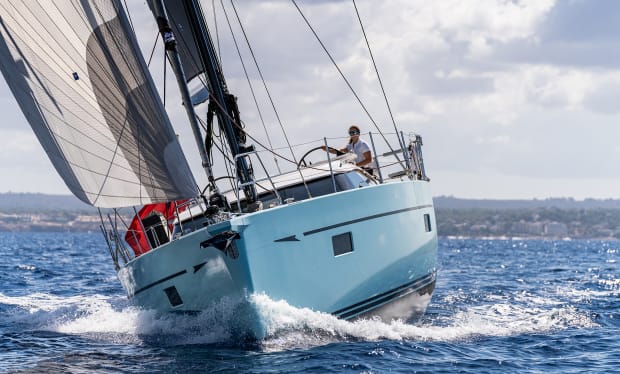
Photo courtesy of Oyster Yachts
The Oyster 495 is a from-the-keel-up new design and an ode to Oyster’s roots. It fully embraces proven offshore sensibilities and is a near replica of her bigger siblings. The design sticks unapologetically to a winning formula of stuff that works.
“At the end of the day, it’s a small Oyster, but it’s got to give you the feel of a big Oyster,” said Chris Lock, the 495’s design lead, in a promotional video about the boat.
Richard Matthews, Oyster’s original founder, helped head up the boat’s planning and development and noted the company’s “legacy of the other sub-50-footers…we felt it was time that Oyster got back into a boat of under 50 feet, but one that brought up to date the modern thinking on what an Oyster yacht should be…a truly bluewater, liveaboard, ocean-going yacht.”
Over the past five decades, boat design has evolved into a greater focus on convenience and sprawling spaces, but some of these modern concepts that look great at a boat show aren’t so practical offshore. That’s where Oyster shines with watertight bulkheads, high cockpit coamings, pre-rigged preventer lines, deck dorades, generous tankage, a low center of gravity, and copious deck stowage. These are the building blocks of a practical cruiser meant for bluewater work.
To bring this boat to market, Oyster implemented a new production process in a new manufacturing space in Hythe on England’s south coast. Construction features include a solid laminate, heavily reinforced, below the waterline as well as in the keel and forward areas of the hull. The structure combines composite stringers and frames for strength, and topsides and deck have closed-cell foam cores for strength and insulation; on deck, this is reinforced with plywood in higher load areas.
At the plumb bow of this Humphreys design is a long bowsprit, aft of which is the Furlex electric headsail furler and the bow roller that positions the anchor away from the bow where it could cause damage. The vertical windlass is on deck just ahead of an anchor locker that could use a larger hatch.
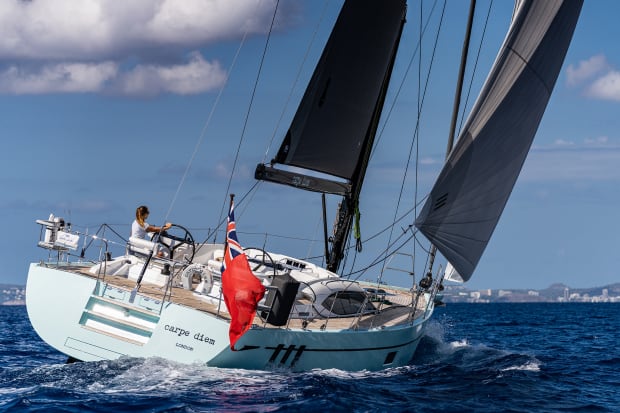
Photo courtesy of Oyster Yachts
The teak-clad decks are flush and wide with integrated gunwales for more secure footing when heeling. The lifelines are high as they should be on a boat in this class, and the reverse transom has integrated steps rather than a drop-down platform, which lead to an electric swim terrace that slides out like a cassette from the hull. Below the waterline are twin rudders and a T-shaped keel, which on our test boat was the optional 7-foot-6-inch version.
Oysters practically invented the deck salon with sleek windows and a coachroof that flow neatly aft into the structure of the protected cockpit, where you’ll find twin wheels on wide, yachty-looking binnacles that make push-button sailing possible. Lewmar EVO series electric primary winches are outboard where they can be reached from the helm, cockpit, or side deck.
Handholds are all around including inboard and outboard of the binnacles and on the fore and aft ends of the cockpit table, which also has a fridge tucked inside. You can walk all the way around the cockpit on one level back to the full-beam lazarette designed to carry loads of cruising gear while it also forms a watertight bulkhead.
Inside, six deep stairs lead to the salon with its L-shaped dinette and an electric hi/lo table to starboard. Forward and past the mast are two more steps down to the VIP cabin in the forepeak and an over/under cabin to starboard. The systems below the raised salon sole include good access to a variety of pumps, fuel and water tanks, and the batteries, which Rob had upgraded from the standard gels to 600 Ah of lithium.
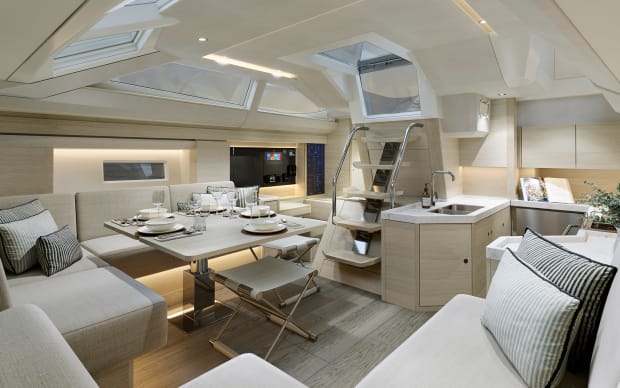
Photo courtesy of Oyster Yachts
The galley is also two steps down and is a model of a proper seaworthy kitchen situated right by the companionway, so it’s easy to pass food up to the cockpit. It’s U-shaped and compact, so you can cook or wash dishes securely, regardless of heel, and the twin sinks are on the centerline to ease draining no matter the angle of the hull. A four-burner stove is propane and gimbaled so you can cook underway without starting the generator, and all the countertops have high fiddles to keep dishes from flying. There’s even red lighting for nighttime food or drink prep that won’t blind the watch. Side engine access is below the sink and a dishwasher is optional, although I’d rather see that replaced with more refrigeration on this distance cruiser, perhaps in the form of a drawer.
The large nav desk is also two steps down from the salon at the head of the starboard passageway to the aft stateroom. Here, you’ll find a freezer and the main engine access doors with the 8 kW Fisher Panda generator tucked in behind. A nod to modern features at the nav station includes CZone digital switching with a proprietary overlay called Oyster Command and a swing-out computer screen. While the number of interior steps and level changes can be tricky, the system organization and well-placed handholds are to be applauded.
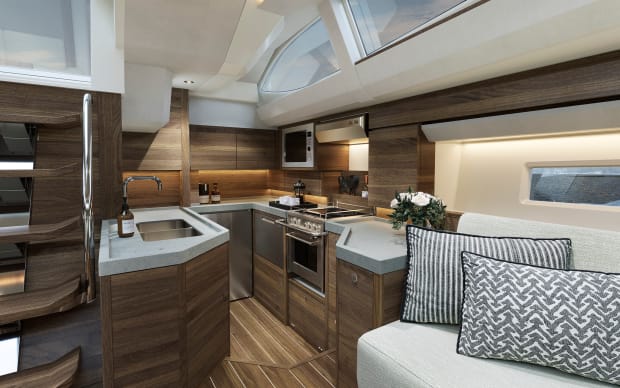
Photo courtesy of Oyster Yachts
The aft stateroom is the star of the belowdecks show. A centerline queen berth is flanked by integrated nightstand drawers. Light pours in from the triple vertical hull windows on either side as well as his- and-hers overhead hatches. A fairly compact head with a generous shower stall is to port. There’s 6 feet 4 inches headroom throughout the suite, which has good stowage and is decorated in tastefully muted colors.
The Oyster 495 has a simple rig with a 105% genoa and a large in-mast mainsail that is standard. A Code 0 is optional. Our test boat had the upgraded carbon fiber, keel-stepped Seldén mast with electric in-mast furling and a hydraulic ram inside the boom to help with furling and reefing. The standard is an aluminum rig, and a fully battened mainsail with end-boom sheeting and a dedicated aft winch are available.
The vang, mainsail furler, outhaul, mainsheet, and backstay are all controlled via buttons at the starboard wheel, so our sailing was leisurely with zero drama. Granted, we had only an 8-knot breeze that occasionally gusted to 11, but the stand-out feature of sailing this Oyster was the quiet with which the sails could be furled and the utter lack of fuss through the tacks.
With the genoa and main in 10 knots at 45 degrees apparent wind angle (AWA), we made good 6.1 knots of boat speed. On a beam reach with 8.5 knots over the deck, we still held onto 5.2 knots of speed. The boat is forgiving and glides along like a Cadillac even with imprecise helming.
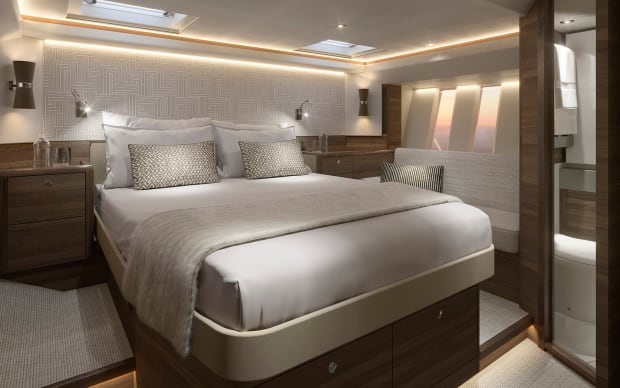
Photo courtesy of Oyster Yachts
The Oyster 495 is powered by a 100-hp Yanmar diesel with a saildrive, which Oyster chose over a shaft drive presumably due to the shape of the hull. At 2,300 rpm, we motored at 9.5 knots, and when barely in gear we spun in our own length with just a finger on the light and responsive helm. Optional bow and stern thrusters from Sidepower made easy work of docking.
The Oyster 495 joins the company’s current 50-90 footers, and like her siblings, she makes sense in the world for which she was created. Fully loaded, she’s around $1.9 million, and if you want the carbon rig, you’ll need to add a bit more although Oyster hasn’t clarified exactly how much. Seventeen have already sold, and if you want to place an order, expect a delivery in the latter half of 2024, which may explain why Rob opted for the first hull.
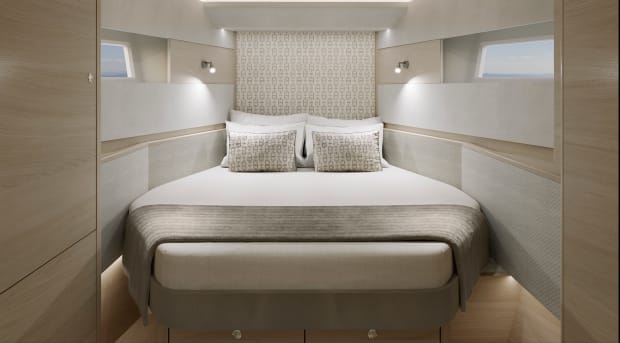
Photo courtesy of Oyster Yachts
“Historically, Oyster made its name in the 50-foot market,” company owner and CEO Richard Hadida said in the promotional video. “The Oyster 495 is going to take us back into that market…she’s a go-anywhere adventure machine.”
I used to keep a picture of an aspirational Oyster 485 on my desk as motivation for a planned circumnavigation that’s still in the works. Since those days, I’ve sailed a lot of boats including some that were faster or had flashier features like deck grills and sun pads, but when I think of going offshore, my money is still on an Oyster with its renowned quality and traditional design. A fresh picture, perhaps of an Oyster 495 this time, may just have to find its way back onto my desk.
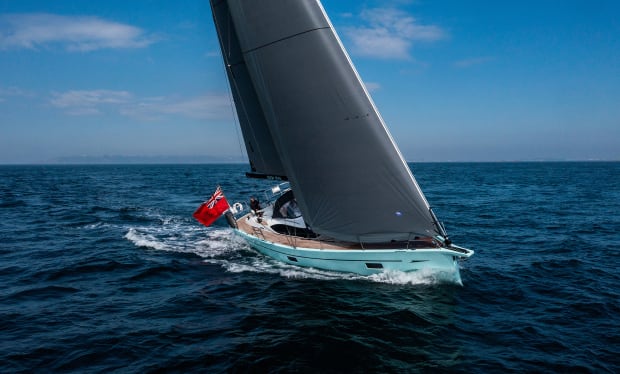
Photo courtesy of Oyster Yachts
Specifications
LOA/LWL 52’ 8” / 46’ 8”
Beam 15’ 8”
Draft/Shoal 7’ 6” / 6’ 0”
Air Draft 74’ 9”
Displacement 46,297 lbs
Sail Area 1,291 sq ft (std)
Power 110-hp Yanmar (saildrive)
Fuel/Water 211/159 gallons
Designer Humphreys Yacht Design
Builder Oyster Yachts, oysteryachts.com
Base Price $1.6 million
May 2023








